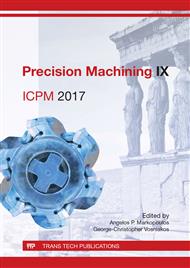p.159
p.167
p.173
p.181
p.189
p.195
p.201
p.207
p.215
Effect of Honing Parameters on Generated Surface Quality of Cylinder Liner within Automotive Engine Production
Abstract:
One of the key parameter in evaluation of cylindrical surface quality of the engine liners is surface roughness. A large number of process factors affecting a final surface topography, which has direct impact on fuel consumption and CO2 emission. A suitable choice of honing conditions can results not only to better surface quality, but it can contributes to reducing of environmental impacts in automobile transport. Twelve different engine cylinder liners were machined in various combinations of cutting parameters. Experimental testing was realised on real production machine tool, where process factors were cutting speed, machining allowance and stone pressure of honing tool. All factors have 4 levels and parameters of surface roughness CR, CF, CL were selected as a variables and suitable indicators for surface quality assessment. The results show that influence of the tool stone pressure on honed surface is more significant than effect of cutting speed. Effect of machining allowance is negligible as well.
Info:
Periodical:
Pages:
189-194
Citation:
Online since:
August 2017
Authors:
Keywords:
Price:
Сopyright:
© 2017 Trans Tech Publications Ltd. All Rights Reserved
Share:
Citation:


